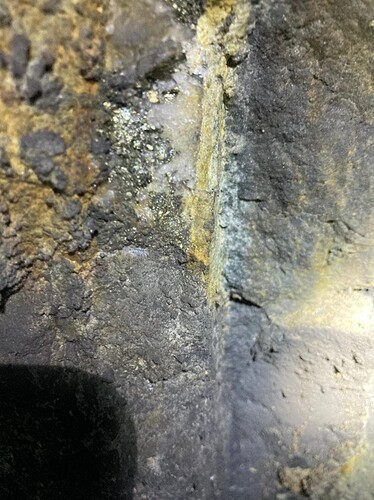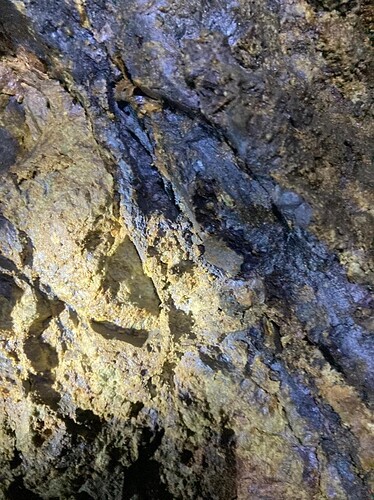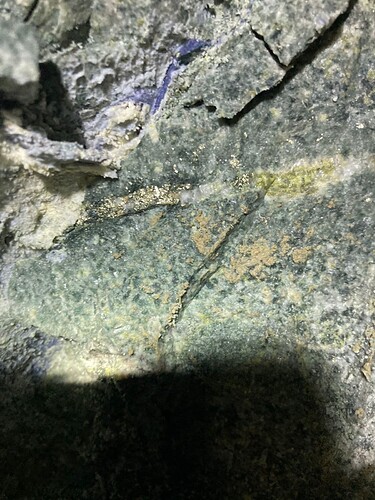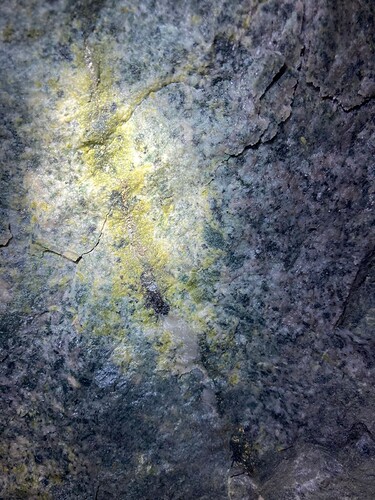Part of the reason I think we’re super-close to the DL1 Vein is the 2 newest pictures on the Auryn twitter page. The one with the 2 parallel veinlets shows classical “banding”. You can see the alternating lighter and darker areas. A lot of the time, it’s the darker bands consisting of “ginguro”, that carry the crazy gold grades. I’ll provide a link in a moment to a really good article on high-grade gold associated with “banding”. Each “band” represents a different phase of mineralization from ore-bearing hydrothermal fluids and gases perfusing the host rock. “Banding” is a very good thing.
https://twitter.com/aurynmining/status/1492153844008112130/photo/1
The second link shows some of the best-looking ore I’ve ever seen at the ADL. You’ve got the supergene enriched copper sitting right next to the SHINY YELLOW STUFF. Either of these could carry the insanely high grades that we saw at the intersection of Shaft A and Level 2 which is near where Auryn is in the Antonino Adit currently. DON’T FORGET THE MAGNITUDE AND LOCATION OF THESE SAMPLE ASSAYS.
https://twitter.com/aurynmining/status/1491505889676775430/photo/1
In the effort to intersect the DL1 Vein proper, what’s important is the CHANGE from what we witnessed in the first 100 or so meters of the Antonino Adit. The presentation of this new ore stands head and shoulders above what we’ve been seeing for quite a while. This is not to take away from the other ore which was impressive in its own right. But these were just “splays” off of the parent structure.
As usual, we need to wait on the assays. If the miners accidentally clipped an “ore shoot” associated with the DL1 Vein, then just don’t be surprised if some of the assays come back pretty crazy. Two things to keep in mind, firstly, ore shoots are huge. Secondly, management can start producing from wherever they darn well please. It could take several years to mine out a super high-grade ore shoot. But again, let’s wait for the assays.
One of the photos on the Auryn “gallery” showed 6 pretty good-sized gold nuggets which had the caption “free gold”. This is on the “Don Luis 1” portion of the Auryn website “gallery”. It is photo #12 of 12. Some veins just have a tendency to produce nuggets periodically. A lot of times they occur in these caves within quartz known as a “vug”. That black “sooty” looking stuff covering the nuggets is typically very high-grade silver.
In those 16 samples taken at the junction of Shaft 4 and Level 2, you might recall that the sample that came in at 1,220 gpt gold ALSO HAD OFF THE CHART SILVER NUMBERS AS MIGHT BE EXPECTED IN A TRUE “ORE SHOOT”. Is this 100% diagnostic of an ore shoot, nope, not yet anyways! I suspect that the 1,220 gpt sample might be a statistical outlier that is certainly NOT “representative” of the “run of mine” grade but depending on its vertical and horizontal extent/”continuity” it could certainly increase the average grades of “gold equivalent” measurably.
At the link below you can read about areas of “banding” within veins:
The opening line states: “High-grade ore zones in low-sulfidation epithermal deposits are commonly associated with the occurrence of banded quartz veins. The ore minerals in these veins are heterogeneously distributed and are mostly confined to ginguro bands, which can be identified in hand specimen based on their distinct dark gray to black color.”
Everybody loves the prototypical picture of visible gold within a nice white quartz vein. But quite often, it’s the ugly dark stuff that packs the punch. Note in the article above how they talk about extremely high-grade gold existing in a quartz vein even though it is invisible to the human eye. Also note how the article refers to how the super high-grade gold within this darker “ginguro” stuff IS THE RESULT OF INTENSE BOILING. I think I’ve crammed down your throats the concept of super high-grade gold being associated with “boiling zones” enough so I’ll try to take a break from this (maybe). We forget about how incredibly rare “visible gold” really is and what kind of grades it can carry. Also keep in mind, however, that pyrite and chalcopyrite can present in a similar SHINY YELLOW STUFF (SYS) fashion.
In order to better the odds of the SYS being gold, you need to go to the next level of understanding. Extremely high-grade gold has a predilection to hang out with that bluish bornite stuff ESPECIALLY IN AN AREA THAT DEVELOPED IN A VERY HIGH HEAT ENVIRONMENT i.e. 450-650-degrees C. The highest heat environment in these hydrothermal systems is the area of “potassic alteration”. How do you know if the bornite you’re witnessing is in a very high-heat environment? You look for the most common “signature” of potassic alteration which is “potassium feldspar” or “K-spar” i.e. that salmon-tannish stuff that’s been making an appearance as the blue stuff made its appearance.
Just my luck, while I’m trying to sign off, it looks like we have 11 new photos on the Q-1,2022 section of the Auryn website “gallery”. #33 of 35 jumps out at me. This looks like what I’d call the extremely high-grade gold “trifecta”. You can see what looks like the bluish bornite stuff up high. You can see the salmon-tannish stuff that appears to be high-heat “K-spar” down lower. The SYS on the right side of that veinlet is a nice YELLOW color. Gold is YELLOW. Pyrite (iron sulfide) is a bronzish-yellowish color that can tarnish. Pyrite doesn’t reflect light like gold does. It has cubic crystals that will bounce light off of its flat cubic faces in different directions. Gold is roundish, it will bounce light back right into your face.
Towards the left side of that same veinlet, you can see more of a bronzish reflection. That could be pyrite or arsenopyrite with associated gold. A lot of the gold at the ADL, up higher in the DL1 Vein structure, was associated with arsenopyrite. Again, let’s wait on the grades.
Photo 35 of 35 again looks like the “trifecta” but the shade of blue is very light. This looks like chrysocolla which is 34% Cu while bornite is 63% Cu. Again, you see what appears to be “K-spar”. These recent photos also indicate the same theme i.e. CHANGE as we get closer to the parent structure. Earlier in the adit, the SYS was disseminated and somewhat circular in outline. You can get rid of some of the glare from the headlamps if you look at the photos with your jeweler’s loupe or a magnifying glass.
Now, all of a sudden, the SYS is yellower and more linear in its appearance and is appearing in distinct veinlets.
In the Auryn website’s “gallery” portion under the heading of “2021 Q-4”, in photo # 22 of 32 you can see a good example of “banding”. You can make out 7 distinct “bands” in this sample. This is a close-up view of the ore that Maurizio was pointing to in photo #14 of 32. These pictures were taken back in November of 2021. This marks the point at which the mineralization zone widened out nicely and a lot of apparent supergene enrichment (the blue stuff) started dominating the scene. With Enami we get to add the grade of the copper to the grade of the gold and speak in terms of “gold equivalent” grades. Each 1% in Cu adds about 1.73 grams per tonne in “gold equivalents”. Whether the copper you’re producing is “acid soluble” from oxide copper or “acid insoluble” from copper sulphides, Enami’s “base rate”/”tarifa” is still 2.5% to qualify for payment.
Here is a link to Enami’s current rate sheet for Feb. of 2022:



